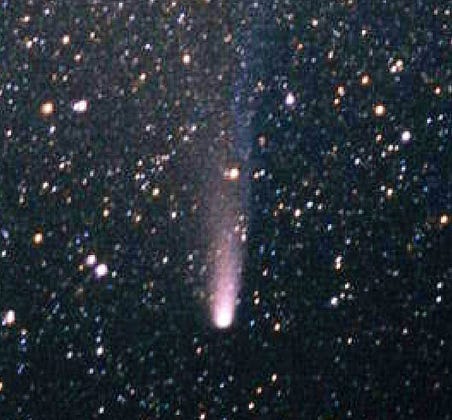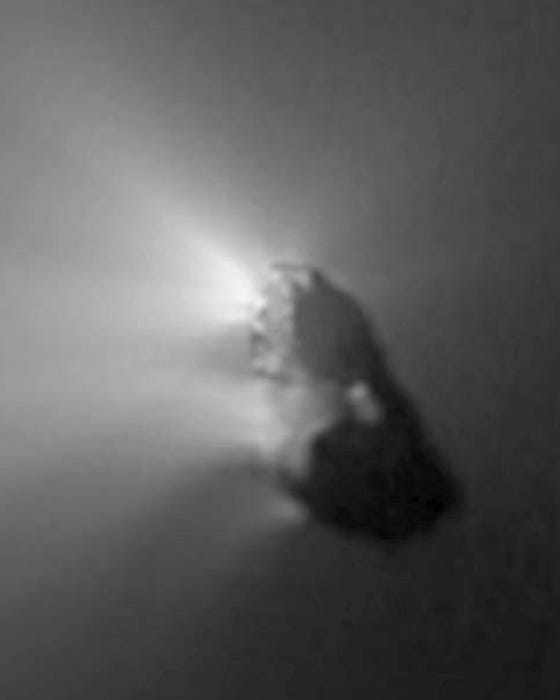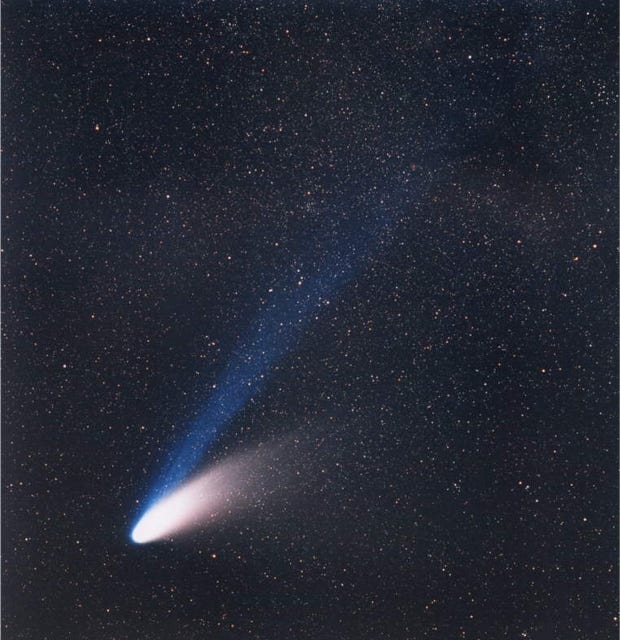
A BRIEF HISTORY OF HALLEY’S COMET
Revised extracts from A Comet Called Halley by Ian Ridpath
(Cambridge University Press, 1985)
Heads and tails
Heads and tails
When far from the Sun, a comet resembles a dirty snowball a few kilometres wide. Only when it reaches somewhere around the orbit of Mars do the Sun’s light and heat awaken the snowball from its hibernation so that it displays itself for the admiration of astronomers.
A comet’s regalia has four components: a nucleus; a coma, which together with the nucleus makes up the head; a tail (although not in all cases); and, around the whole comet, a bubble of hydrogen, millions of kilometres across, invisible to the eye but detectable by instruments in space.
The fount of all cometary activity is the nucleus, the dirty snowball, composed mostly of frozen water caked with dark dust. Under the warming influence of the Sun, fountains of evaporating ice burst through the crust to form an enveloping halo of gas and dust, the coma. An ordinary comet’s coma is about 10,000 kilometres wide, big enough to engulf the Earth, but in the greatest comets, Halley’s among them, the coma spans more than 100,000 kilometres, half the distance from the Earth to the Moon. For all its size, the coma is still transparent – stars can be seen shining through it, as they can through the tail. The gases of a comet are far thinner than your breath.
In the popular mind a comet would not be a comet without its tail, but in truth the majority of comets are as tailless as a Manx cat. Amputee comets are almost invariably faint, though, so just about every comet that you are likely to see with the naked eye will have a tail, or possibly two: one composed of gas and one of dust. You can tell the two apart because the tail of gas is straighter, whereas the tail of dust is more curved and smudgy. Note that the direction in which a comet spreads its tail is no clue to the course the comet is steering, for a tail is not the wake of a comet. Rather, the tail blows away from the Sun, so a departing comet actually chases its own tail.
Gas and dust
Gas tails of comets are evidence that there is a ‘wind’ of sorts in space, known as the solar wind. This is a stream of atomic particles from the Sun which blows gas away from the comet’s head like a flag in a breeze. Bombarded by the Sun’s ultraviolet light, the gas in the tail fluoresces like an advertising sign, as does the gas in the coma, producing an ethereal self-luminance. Gas tails can stretch for 100 million kilometres or more, as did that of Halley’s Comet in 1910.
Dust tails are shorter, and shine simply by reflecting sunlight. Impacts by photons of sunlight push dust specks away from the comet’s head, an effect known as radiation pressure. As the dust recedes from the head it spreads out into a fan shape.
Clearly, a comet pays dearly for its moment of glory when near the Sun by irretrievably shedding mass – over a hundred million tons each trip, in the case of a bright comet like Halley’s. Yet the nucleus is big enough to survive thousands of returns. ☄
The black heart of Halley
The nucleus of Halley’s Comet, a dust-encrusted block of ice with a surface as dark as soot, as photographed by the European space probe Giotto in 1986 March. It was 15 km long by 7 km wide, larger than many astronomers had expected. Gas and dust was spraying out from the nucleus through cracks in the surface. The ‘dirty snowball’ model of comet nuclei was put forward by the American astronomer Fred Whipple in 1950, but Halley’s nucleus was the first to be seen. (Image from Max Planck Institute for Solar System Research.)

